Armed with a tape recorder and open ears, Tony Schwartz turned everyday noise into lasting art. Now, his recordings live on at Smithsonian Folkways, where they continue to inspire new ways of listening to, remembering and understanding the world
Ella Jeffries - Staff Contributor
June 16, 2025

On the bustling streets of midcentury New York City, Tony Schwartz carried with him a sense of curiosity about everything he heard. He might stop mid-step to catch the hiss of a steam grate or the clatter of a pushcart. In a city defined by movement, Schwartz was still—ears open, recorder in hand. Rather than look, he listened. Whether it was children skipping rope, cab drivers recounting stories or the click of a rotary phone, Schwartz heard music in the mundane.
“He was just fascinated with sounds,” says Anton Schwartz, his son.
His 1950s album Sounds of My City, released through the Folkways Records label, captured a sonic portrait of Manhattan that no one else was collecting. Listeners can hear peddlers calling out their wares, children singing in courtyards, band music echoing on side streets and immigrant voices drifting through Midtown Manhattan. Schwartz assembled the symphony of a city in motion.
Founded by Moses Asch, Folkways broke new ground as a record label devoted to documenting culture through sound. Asch believed that audio could be a tool for education and cultural preservation. He sought to publish not only music but also oral histories, environmental recordings and community voices, creating a space where unconventional work like Schwartz’s could thrive. “There was probably no other outlet for him,” says Jeff Place, curator and archivist at Smithsonian Folkways.
After Asch’s death in 1986, the label was acquired by the Smithsonian Institution and became Smithsonian Folkways Recordings. Today, Schwartz’s work lives on in the archives of Smithsonian Folkways, where curators and listeners alike continue to rediscover his singular contributions to audio culture. His efforts anticipated modern ideas about sound archiving, an ongoing process of selecting, contextualizing and making meaning from recordings so that they resonate beyond their original moment.
What makes Schwartz’s recordings particularly valuable is how they collapse the distance between artist and archivist. He was both collector and composer, finding beauty in overlooked sounds and giving them new resonance through curation. In this way, his work helped shape the modern understanding of what sound archives can be: not just repositories, but instruments of memory, meaning and access.
/https://tf-cmsv2-smithsonianmag-media.s3.amazonaws.com/filer_public/ad/34/ad347485-ada7-4da8-a8bc-46f7adf950b4/tonyniceyoungposebybunnyadleroriginal_1.jpg) Portrait of a young Tony Schwartz
Bunny Adler / Courtesy of Anton Schwartz
Portrait of a young Tony Schwartz
Bunny Adler / Courtesy of Anton Schwartz
Though Schwartz is best known for his advertising work—most famously the 1964 “Daisy” political ad for Lyndon B. Johnson—Place sees Sounds of My City as a foundational work in the history of field recording. “He did what no one else was doing,” Place says. “He went around recording all sorts of stuff, people in the streets, noises of machines.” Schwartz even recorded a long-unreleased piece called “Out My Window,” an ambient recording of city sounds from a single vantage point. “You could actually close your eyes and pretend it’s 1950 and that you’re on the street in New York,” Place says.
Schwartz spent decades wandering his Hell’s Kitchen neighborhood with a custom-built portable recorder, capturing snippets of city life. “He built it into a suitcase,” Anton says. “He would go around the streets of New York and record things that were of interest to him.”
Those interests were wide-ranging. He made recordings of everything from street buskers to the hum of traffic. Schwartz believed sound offered an unfiltered lens into the culture of everyday life. David Garland, a longtime radio host who interviewed Schwartz for WNYC in 1989, recalled the archivist’s home as entirely consumed by sound: “Where you might find a living room, there were just shelves and shelves and shelves of tapes everywhere.”
Garland admired not only Schwartz’s instincts, but also his originality. “You don’t meet too many people who not only have their own point of view on the world but then sort of build a whole unique career out of that,” he says. “He just got stuff done. It was all motivated by curiosity and this kind of enthusiasm.” Even years later, Garland says he carries Schwartz’s lessons with him—not just in method, but in mindset. “A lot of people get hung up on technical things and equipment. Tony didn’t. Whatever let him sort of capture the moment and make it speak to other people, that was his goal.”
He wasn’t trying to preserve the great speeches or canonical music. Instead, he leaned into the ephemeral, the sounds most people tuned out. “What we now know as the world of the 1950s then was just the world,” Anton says. “He came at it with a different perspective, and it gives us a historical perspective on this time.”
“His work is a model of the possibilities of listening intensely to what’s going on and listening deeply in such a way that you can pick up on all sorts of things that you wouldn’t notice in the course of daily life,” he adds.
"Daisy" Ad (1964): Preserved from 35mm in the Tony Schwartz Collection

For the album Sounds of My City, Schwartz recorded ice cream trucks and subway conductors, snippets of Puerto Rican communities in Lincoln Square, and a taxi driver from Mississippi singing spirituals as he drives down Park Avenue. It offers an audible mosaic of the time that, as Place notes, would have otherwise vanished. “If no one had recorded them, then we’d have no idea what it sounded like,” he says.
His recordings were more than documentation—they were art, advocacy and personal expression. He created a series of anti-smoking public service announcements using only the giggles and play of children. One commercial shows kids dressing up as their parents, ending with the stark lines, “Children learn by imitating their parents. Do you smoke cigarettes?” He was one of the first to use real children’s voices in advertising, breaking away from the industry’s tradition of using adults to impersonate kids.
And his creativity didn’t stop at advertising. Schwartz once made an experimental montage blending a Coca-Cola jingle with soundbites from Richard Nixon’s Watergate speeches, an evocative and surreal sonic collage that captured the contradictions of American life. “It was an example of the subtlety of his ear for sound and the creativity of how he would use sound. And also of his humor—he was a very funny person,” Anton says.
While Smithsonian Folkways holds the recordings tied to Schwartz’s albums, the broader Tony Schwartz Collection, thousands of tapes, can be found at the Library of Congress. The scale of the archive is enormous: an entire room of wall-to-wall audio reels. “He had a whole thing called ‘The World in My Mailbox,’ where people from all over would send him tapes,” Place says. “He didn’t need to travel; he could build a world of sound from his own living room.”
Place also emphasizes the responsibility sound archives have today not just to preserve, but to educate. “It’s not helping anybody if it’s just sitting in boxes,” he says. “The idea is to get it out there for people.” He regularly builds web exhibits, creates annotated listening experiences and writes contextual guides to help listeners understand what they’re hearing. Without this effort, Place warned, recordings risk becoming meaningless data—files on a screen with no story behind them.
Now, as smartphones allow anyone to capture high-quality sound, the role of the professional archivist has shifted. Still, Place notes that the mission to collect, contextualize and share remains constant. “Our job is to give people the tools to understand why the recording matters,” he says.
In that spirit, Sounds of My City endures not just as an archive of the past, but as a call to engage with the world more attentively. In a time when sound is as abundant as ever and attention is scarce, Schwartz’s legacy reminds people that the everyday is worth listening to and remembering.
.png)




